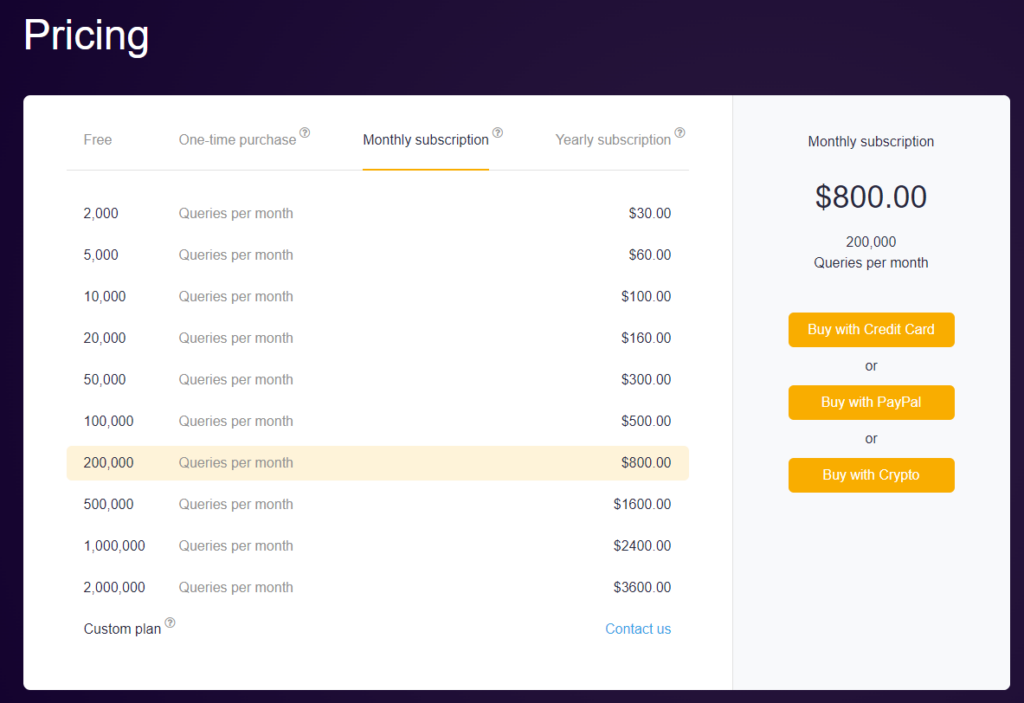The Whois.com API is a powerful tool that allows developers to access a vast repository of domain ownership and registration data. With over 565 million active domains and 7,596 top-level domains (TLDs) tracked, the Whois.com API provides a comprehensive and up-to-date source of information for a wide range of applications.
In this guide, we will delve into the intricacies of the Whois.com API, exploring its features, capabilities, and practical applications. We will also provide detailed instructions on how to integrate the API into your projects, ensuring seamless access to valuable domain insights.
Features and Capabilities
The Whois.com API offers a plethora of features and capabilities that cater to the diverse needs of developers and businesses. Here are some of the key highlights:
1. Extensive Domain Coverage: The API provides access to WHOIS data for over 565 million active domains, covering a wide range of TLDs, including .com, .net, .org, and many more.
2. Comprehensive Data Points: The API retrieves a comprehensive set of domain ownership and registration data, including registrant information, contact details, creation dates, expiration dates, and more.
3. Real-Time Updates: The API delivers real-time updates on WHOIS data, ensuring that you always have access to the most current information.
4. Scalable and Reliable: The API is designed to handle high-volume traffic and is backed by a robust infrastructure, ensuring reliable access to data.
5. Customizable Output Formats: The API allows you to customize the output format of WHOIS data, making it easy to integrate into your applications.
6. Flexible Integration Options: The API offers various integration options, including client libraries, integration modules, and direct API calls.
| Feature | Description |
|---|---|
| Extensive Domain Coverage | Access to WHOIS data for over 565 million active domains across a wide range of TLDs |
| Comprehensive Data Points | Retrieves a comprehensive set of domain ownership and registration data, including registrant information, contact details, creation dates, expiration dates, and more |
| Real-Time Updates | Delivers real-time updates on WHOIS data, ensuring you always have access to the most current information |
| Scalable and Reliable | Designed to handle high-volume traffic and backed by a robust infrastructure for reliable data access |
| Customizable Output Formats | Allows you to customize the output format of WHOIS data for easy integration into your applications |
| Flexible Integration Options | Offers various integration options, including client libraries, integration modules, and direct API calls |
Practical Applications of WHOIS.COM API
The WHOIS API is a powerful tool that can be used for a variety of purposes. Here are some of the most practical applications of the WHOIS API:
Domain monitoring and tracking
The WHOIS API can be used to monitor and track domain registration and expiration dates. This can be useful for businesses that want to keep track of their own domains or for domain resellers who want to identify potential opportunities for acquiring new domains.
Brand protection
The WHOIS API can be used to identify potential instances of trademark infringement. For example, a company can use the WHOIS.com API to identify domains that are similar to their own or that use their trademarks in an unauthorized way.
Marketing research
The WHOIS API can be used to gather domain ownership information for statistical analyses. This can help businesses to make tailor-fit marketing strategies and campaigns for various user bases and identify otherwise-untapped opportunities.
Sales lead generation
The WHOIS.com API can be used to gather contact information for domain owners. This can be useful for businesses that want to generate sales leads or for domain registrars who want to reach out to potential customers.
Fraud prevention
The WHOIS API can be used to identify potential fraud. For example, a financial institution can use the WHOIS API to identify domains that are registered with suspicious contact information.
Technical support
The WHOIS API can be used to provide technical support to domain owners. For example, a domain registrar can use the WHOIS API to identify the technical contact for a domain and then provide that contact with support information.
Compliance
The WHOIS.com API can be used to comply with certain laws and regulations. For example, some countries require businesses to keep certain records about their domain ownership. The WHOIS API can be used to gather this information and comply with these requirements.
In addition to these practical applications, the WHOIS API can also be used for a variety of other purposes, such as research, development, and education.
Here are some specific examples of how the WHOIS API can be used in these areas:
- Research: Researchers can use the WHOIS API to study domain ownership patterns and trends. This information can be used to identify new opportunities for research and development.
- Development: Developers can use the WHOIS API to create new applications and services. For example, a developer could create an application that uses the WHOIS API to provide domain registration and expiration alerts.
- Education: Educators can use the WHOIS API to teach students about domain ownership and registration. This can be a valuable tool for teaching students about the internet and how it works.
The WHOIS.com API is a versatile tool that can be used for a variety of purposes. By understanding the practical applications of the WHOIS API, you can start to use this powerful tool to your advantage.
Integrating the Whois.com API
Integrating the Whois.com API into your applications is a straightforward process. Here’s a step-by-step guide:
1. Create an Account: Sign up for a Whois.com account and obtain your API key.
- Sign up for a Whois.com account if you don’t already have one.
- Navigate to the “API” section in your Whois.com account dashboard.
- Click on the “Create API Key” button.
- Provide a descriptive name for your API key and click “Create.”
- Your API key will be displayed. Copy and store it securely.
2. Choose an Integration Method: Decide whether to use client libraries, integration modules, or direct API calls.
3. Familiarize Yourself with Documentation: Thoroughly review the API documentation to understand the available methods, parameters, and response formats.
4. Implement API Calls: Integrate API calls into your application’s code to retrieve WHOIS data.
- Use the Whois.com API documentation to understand the available endpoints and request parameters.
- Construct API requests using the appropriate HTTP method (GET, POST, PUT, DELETE) and URL structure.
- Include your API key in the request headers or request body as specified by the API documentation.
- Send the API requests to the Whois.com API endpoints using an HTTP client library in your programming language.
5. Handle Responses: Parse and process API responses to extract relevant information.
- Parse the JSON or XML responses returned by the Whois.com API.
- Extract the relevant domain registration and ownership data from the response.
- Handle any errors or exceptions that may occur during the API interaction.
- Integrate the extracted data into your application or service as needed.
6. Test and Deploy: Thoroughly test your application’s integration with the API before deployment.
Here’s an example of a simple API request to retrieve Whois information for a domain:
Python
import requests
domain_name = "example.com"
api_key = "YOUR_API_KEY"
url = f"https://api.whois.com/whois/{domain_name}?apiKey={api_key}"
response = requests.get(url)
if response.status_code == 200:
# Parse and process the JSON response
whois_data = response.json()
print(whois_data)
else:
print(f"Error: {response.status_code}")WHOIS API Pricing and Plans

Whois API pricing plans vary depending on the provider and the volume of queries you need. Most providers offer tiered pricing with increasing query limits and additional features as you move to higher tiers.
Here’s an overview of the pricing plans from a few popular Whois API providers:
| Provider | Plan | Queries/Month | Price | Features |
|---|---|---|---|---|
| WhoisXML API | Free | 50 | $0 | Basic Whois lookup |
| Starter | 1,000 | $30 | Basic Whois lookup, historical data | |
| Standard | 5,000 | $60 | Advanced Whois lookup, bulk data export | |
| Premium | 10,000 | $100 | Advanced Whois lookup, bulk data export, domain monitoring | |
| RapidAPI | Basic | 30,000 | $10 | Basic Whois lookup |
| Pro | 150,000 | $30 | Basic Whois lookup, historical data | |
| Ultra | 500,000 | $80 | Advanced Whois lookup, bulk data export, domain monitoring | |
| DomainTools | Starter | 10,000 | $99 | Basic Whois lookup, historical data |
| Standard | 25,000 | $199 | Advanced Whois lookup, bulk data export | |
| Pro | 50,000 | $299 | Advanced Whois lookup, bulk data export, domain monitoring | |
| Enterprise | Custom | Custom | Advanced Whois lookup, bulk data export, domain monitoring, custom features |
As you can see, pricing ranges from $0 for basic plans with low query limits to several hundred dollars per month for enterprise-level plans with high query limits and advanced features.
The specific plan that’s right for you will depend on your individual needs and budget.
Here are some additional factors to consider when choosing a Whois API provider:
- Data quality and reliability: Make sure the provider uses accurate and up-to-date Whois data.
- API coverage: Check if the provider covers the TLDs (top-level domains) you’re interested in.
- Ease of use: Look for a provider with clear documentation and easy-to-use API tools.
- Customer support: Consider the provider’s level of customer support in case you need assistance.
Once you’ve chosen a provider and plan, you’ll need to integrate the Whois API into your application or service. This typically involves making API requests to retrieve Whois data and parsing the JSON or XML responses.
The specific integration process will depend on the programming language and framework you’re using.
Wrap!
The Whois.com API is an invaluable tool for developers and businesses seeking access to comprehensive domain ownership and registration data. With its extensive features, scalable performance, and numerous practical applications, the Whois.com API empowers users to make informed decisions, protect their brands, and enhance their marketing strategies. Whether you’re conducting market research, preventing fraud, or simply gathering domain insights, the Whois.com API has the power to transform your operations and achieve your goals.
Read also:
